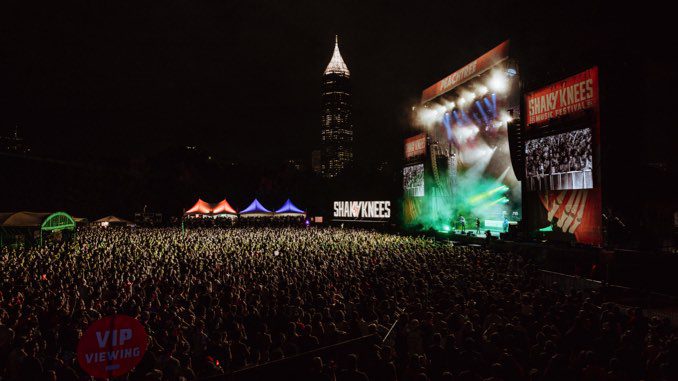For years, Paste has introduced exciting, up-and-coming artists to our readers. This is the return of The Best of What’s Next, a monthly profile column which highlights new acts with big potential—the artists you’ll want to tell your friends about the minute you first hear their music. Explore them all here.
What kind of music can you play when you’ve already played a little bit of everything? For the longtime session musician Rachika Nayar, whose own extensive genre-expansive curiosities have manifested since her preteen years, an answer to that question did not come easily. The Brooklyn DIY scene taught her that she could follow any creative avenue she wanted—and in a way, she wanted to follow them all in her own compositions. What she found to accomplish that—digitally processing her guitar into an obliterative state—turned out to be a stroke of genius.
On two LPs and an EP released over a year-and-a-half span, Nayar has made it clear that our instruments and our hands are not limited to a small, naturalistic array of sounds. Through annihilating her guitar alongside strings, electronics, percussion samples and the occasional vocal, Nayar imbues her music with an undeniable haptic quality, somehow capturing the community-building sense of communal touch while also charting an emotionally transformative solitude.
Nayar gets herself settled for a dusk-hour FaceTime call from Greenpoint, where she came after work to bask in the sunset. Throughout our conversation, the sun slowly drips below the horizon while Nayar soaks in the waterfront breeze. Behind her, Brooklyn remains lanky and stoic, the glass windows repeating back what the sun utters first. It is here where Nayar reflects on the diverse experiments and projects that have informed her work over the last decade and change as she began composing more seriously.
“I started playing guitar when I was 10, and it remains my primary tactile relationship to music. But my relationship to music has gone through a lot of different iterations, from making synth-pop with my close friends in high school to making Drum & Bass breakdowns in Ableton,” Nayar begins. In high school, she found herself drawn to the work of Burial, especially the self-titled project, for his ability to construct vivid portraits of alienation while being somewhat mysterious and contextless himself. That kind of artistic ego death, or creation from a subjectless space, continues to inspire Nayar.
From the beginning, production and composition felt like spaces through which to express her curiosity, but as she came up in the Brooklyn DIY scene, Nayar found herself drawn to contributing her guitar stylings to a wide variety of friend-led projects. She followed every “stylistic impulse” she could, playing in bands (including Brooklyn queercore legends Mallrat), improvisational duos and more. When it came to composing her own music, Nayar gravitated towards digitally processing her preferred instruments in order to draw in her influential Midwest emo and post-rock experiences, but mold them into something entirely new and entirely her own.
“When I’m trying to speak to myself creatively, I go to the guitar,” Nayar explains. “But I felt like I would get into ruts with certain shapes, hand patterns, fingerings, harmonies and chord progressions. I was having difficulty finding newness that created a spark. Through taking the guitar apart, I was working with something familiar, but felt like the guitar had new life again.”
From those initial tinkerings, Nayar produced “Losing Too Is Still Ours,” a seven-minute, two-movement composition produced in collaboration with the ethereal Brooklyn-based artist Yatta Zoker. Completing that track showed Nayar that she was onto something—that perhaps she should continue. Spinning and reweaving guitar phrases with accompaniment from piano, cello, synthesizer and more became Nayar’s calling card on Our Hands Against the Dusk, which she released on NNA Tapes in March 2021. Tracks like “No Future,” “Aurobindo” and “The Trembling of Glass” caught listeners’ attention with their challenging textures and disorienting sonic apparitions. “The Trembling of Glass” especially stood out with its tough, mind-bending initial entrance that retreats into its original, improvised guitar loops, offering a glimpse at Nayar’s process. While performing her compositions still feels new and uneasy for Nayar, she recognizes that “No Future” is her favorite to perform: “[‘No Future’] is tied to a really close friendship with Issei, who has played cello on it live since last year. It’s reinvented the song to see someone I love pour such raw, visceral energy into it. The musical connection up there feels like something I’m bound to, in a good way.”
Nayar recalls, “Evan [Welsh] at NNA Tapes saw me open for Laraaji at The Park Church Co-op in Brooklyn, and from then on he was supportive of the album. I’d also been in touch with RVNG Intl. and they saw a bunch of videos I’d posted of myself playing guitar on Instagram, which were pretty disconnected from the album. But they asked, ‘Wouldn’t it be cool to release all those fragments as a project?’”
Those fragments ended up on a cassette release for RVNG Intl. imprint Commend as the aptly named EP fragments, released in August 2021. Over 11 tracks and just about 20 minutes, Nayar collects guitar loops made into whole pieces with reverb pedals, using them to construct intricate layers. fragments is a hypnotic glance under the hood of Nayar’s compositions. Each etude is a world unto itself, rendered entrancing through her virtuosic playing of improvisational loops that find root in her trans-genre experiences. Between Our Hands Against the Dusk and fragments, 2021 proved the year of the processed guitar, both for Nayar herself and for much of ambient music. The waves Nayar’s compositions made within the transnational ambient music scene have made her a new fixture in a scene that is constantly challenging itself to create something novel and brilliant.
Today (Aug. 26), Nayar releases her second LP, Heaven Come Crashing, again via NNA Tapes. As evocative as her previous collections have been, on this one, Nayar sought new sensations through maximalist electronics. Her thoroughly processed guitar remains a focal point indeed, but in a more expansive nexus than in any prior Rachika Nayar release. On Heaven Come Crashing, trance music enters Nayar’s audio spectacle, particularly on tracks like “Tetramorph,” “Nausea,” “The Price of Serenity” and “Our Wretched Fate.” Each gentle breakdown is enough to conjure the dance floor at a rave, which is precisely where Nayar’s inspiration originates.
“There is something about rave spaces that feels like the peak form of musical performance for me,” Nayar identifies. In that space, she sees the performer not as the embodied center of attention so much as a spectral vibe curator, ideally invisible to the event’s attendees. The imageless, figureless, subjectless performer crafts a social space where exploration, interconnectedness and ego death can proliferate in the fog, music and lights. The ritualism in rave spaces attracts Nayar; the sense of complete immersion proves most alluring.
Nayar continues, “I feel like one thing people get wrong [about rave culture] is that it’s a social space identical to, say, going to a bar. There’s a shared solitary experience for attendees instead of boundless communalism. There’s a lot of possibility in that shared experience. On the flipside, it’s not inherently a space for extreme revolutionary possibility. There are so many ways in which rave culture has been amputated/decontextualized from its original political ramifications as a space for queer people of color to gather.” That nuanced appreciation for what raves offer, particularly in shared solitary experience, is apparent on Heaven Come Crashing. What makes the Frankfurt sound of trance feel so liberating are the gentle ascents and breakdowns that inflate and deflate throughout, particularly on “Nausea,” Nayar’s most danceable work yet.
The shared solitary experience of the rave is something Nayar gestures towards with frequency. In an epigraph on the Heaven Come Crashing Bandcamp page, Nayar shares a quote from Roland Barthes’ work How to Live Together:
Fantasy is scenario, but a scenario in bits and pieces—always very brief, just a glimmer of the narrative of desire. What’s glimpsed is very sharply contoured, very brightly lit, but all of a sudden it’s gone: a body I catch sight of in a car as it goes round a bend, before it plunges into the shadows“
This appreciation for fantasy and the fantastic is apparent throughout Heaven Come Crashing, and gestures towards Nayar’s fascination with shared solitary experiences. Through fantasy, one can dream alternative networks of kinship that resist traditional hierarchies. Barthes and Nayar both gesture towards alternatives, and the need to appreciate the fantastic in community. At the same time, it is impossible to truly isolate and escape those troublesome hierarchies, so through alternative affinities, there must be a way forward.
Central to Heaven Come Crashing for Nayar is the role of melodrama. “I have a deep suspicion of my own emotionality,” she qualifies. However, for the album, Nayar embraced the full, fantastical breadth of her emotions and their representations. The trance swells and releases communicate the highs and lows of her emotions with euphoric clarity. Nayar identifies two companion songs, album bookends “Our Wretched Fantasy” and “Our Wretched Fate,” as the melodramatic, overflowing emotional gestures towards which she is reaching. She delved back into her youth for inspiration, identifying early M83 and Explosions in the Sky as sources of explosive electronic and post-rock affect. She also draws on her adolescence for inspiration on the nearly 10-minute “Tetramorph.” “I remember being in high school and listening to ‘Impossible Soul’ by Sufjan Stevens. That song is a journey that can take you through so many realms and spit you back out,” Nayar admires.
While Nayar previously featured the incredible vocal stylings of Yatta Zoker, she has resisted lyrics in her music up until select moments on Heaven Come Crashing. “I like for my music to explore something open-ended or, in some ways, preverbal,” Nayar notes. “Lyrics can feel like they’re pinning the music down into something directly referential.” However, after she first heard their 2021 EP, Devil’s Rain, she struck up a working friendship with Maria BC that blossomed into two collaborative tracks. Nayar explains, “Their lyrics are vivid but suggestive, with an incredibly connotative, poetic sense about them.” Once she wrote “Heaven Come Crashing,” she was pleased with the depth it offered, but knew it needed some kind of voice to lift it to its full potential. It was a huge leap of faith for the instrumentalist to invite Maria to craft something for the record, but Nayar could not be happier with the results. “Heaven Come Crashing” and album closer “Our Wretched Fate” feature the voice and word so delicately that it would be hard to say they overshadow, but they add an urgency to the songs that renders them true standouts on an already-expressive record.
While she remains proud of the aural universes she has constructed with her guitar and her electronics, Nayar finds herself intrigued by the potential to put away old reliable and pick up new skills. “I’m interested in restructuring my relationship to my own tools yet again,” Nayar concludes. “I’ve been feeling a tad stale; I might stop playing guitar and process different instruments.” She’s also considering alternative modes of composition—over the years, compositions have emerged slowly, with albums forming organically over time as the completed pieces accumulate. Now, she wonders what might happen if she locked herself in a space with a plethora of instrumental tools for a brief period of time. She elaborates, “I’m interested in what happens if I’m a little more contained in terms of time and space.” Whatever will come out of these sessions, and with whatever tools she selects for manipulation, Rachika Nayar will undoubtedly tug at those nagging artistic quandaries that seem impossible to address—impossible, that is, unless you’re Rachika Nayar.
Heaven Come Crashing
is out now on NNA Tapes.
Devon Chodzin is a critic and urban planner with bylines at Slumber Mag, Merry-Go-Round and Post-Trash. He is currently a student in Philadelphia. He lives on Twitter @bigugly



